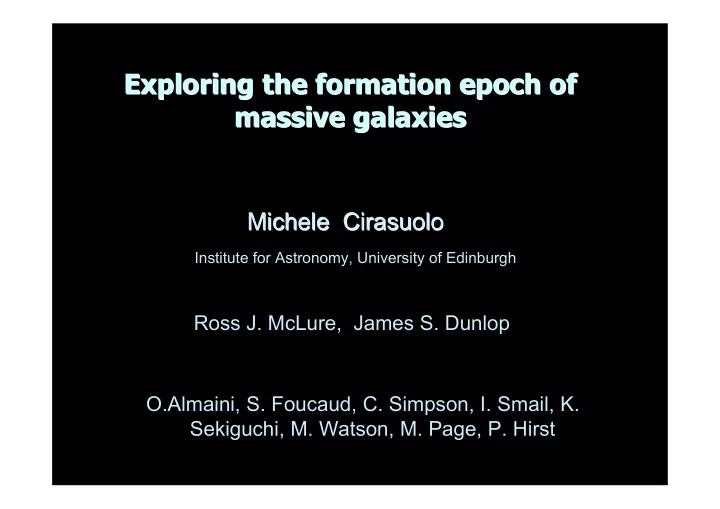

Exploring the formation epoch of Exploring the formation epoch of massive galaxies massive galaxies Michele Cirasuolo Cirasuolo Michele Institute for Astronomy, University of Edinburgh Ross J. McLure, James S. Dunlop O.Almaini, S. Foucaud, C. Simpson, I. Smail, K. Sekiguchi, M. Watson, M. Page, P. Hirst
Delineating cosmic star-formation history Delineating cosmic star-formation history 1) Direct observation of star-formation activity with z Hopkins 2006
Delineating cosmic star-formation history Delineating cosmic star-formation history 1) Direct observation of star-formation activity with z 2) From the fossil record (e.g. Heavens et al. 2004)
Delineating cosmic star-formation history Delineating cosmic star-formation history 1) Direct observation of star-formation activity with z 2) From the fossil record (e.g. Heavens et al. 2004) 3) By measuring stellar mass in place as a function of z Needs • deep near-mid infrared surveys with • multi-frequency supporting data
Deep IR surveys Deep IR surveys e.g. K20, FIRES, MUNICS, GDDS, K21, GMASS, GOODS... UKIRT Infra-red Deep Sky Survey UKIRT Infra-red Deep Sky Survey
UKIDSS Ultra Deep Survey UKIDSS Ultra Deep Survey !"# $%&'# Courtesy of Omar Almaini
UKIDSS Ultra Deep Survey UKIDSS Ultra Deep Survey
UKIDSS Ultra Deep Survey UKIDSS Ultra Deep Survey Cirasuolo et al. 2006, 2007 K(AB) = K(Vega) +1.9 ~50,000 IR-selected galaxies with K(AB) < 23 over an area of 0.7 sq. deg GALEX FUV, NUV SUBARU B,V,R,I,z 16 wavebands photometry available CFHT u,g,r,i,z UKIRT J, K Spitzer IRAC 3.6, 4.5 µm And by the beginning of next year: – H band data UKIRT – Deeper u-band from CFHT – 300h with Spitzer IRAC and MIPS 24µm – 290h VLT time with VIMOS and FORS
Quality of the dataset Quality of the dataset � = 0.036 ~1200 galaxies with good quality spectra <3% of outliers
Evolution of the near-IR galaxy LF Evolution of the near-IR galaxy LF 50,000 galaxies with K(AB) � 23.0 Schechter function with Luminosity evolution 0.5<z<1.0 1.0<z<1.5 1.5<z<2.0 + Density evolution 2.5<z<3.0 2.0<z<2.5 3.0<z<4.0 M K (AB) Local K-band LF from 2MASS
Evolution of the near-IR galaxy LF Evolution of the near-IR galaxy LF Comparison with some results in literature Saracco et al. 2006 Caputi et al. 2006 0.5<z<1.0 1.0<z<1.5 1.5<z<2.0 Pozzetti et al. 2003 2.5<z<3.0 2.0<z<2.5 3.0<z<4.0 M K (AB)
Evolution of the near-IR galaxy LF Evolution of the near-IR galaxy LF Comparison with semi-analytical models De Lucia 2006 Bower 2006 0.5<z<1.0 1.0<z<1.5 1.5<z<2.0 2.5<z<3.0 2.0<z<2.5 3.0<z<4.0 M K (AB)
The colour colour bimodality bimodality The Early type Well studied in the local Universe Visvanathan & Sandage 1977; Bower et al. 1992; Starteva et al. 2001; Baldry et al. 2004 Extended up to z � 1 Bell et al. 2004; Willmer et al. 2005; Franzetti et al. 2006 Late type Baldry et al. 2004 Bell et al. 2004 Combo-17 R < 24
The evolution of colour colour bimodality bimodality The evolution of Primary selection in K-band � No bias against red objects Confirm the luminosity dependent colour bimodality at z<1 Reddening Strength decreases with redshift and seems to Star formation disappears by z>1.5
LF by colour colour type type LF by
The most massive galaxies The most massive galaxies
The most massive galaxies The most massive galaxies Local space density 15 – 20 % of local massive galaxies M * > 10 11 M � in place before z~3 � M CDM > 5 � 10 12 M � M CDM > 2 x 10 12 M � GOODS ( Caputi et al. 2006 ) The assembling of 80% of massive galaxies occurs in the range 1 < z < 3
The obscured growth The obscured growth Central 400 arcmin 2 of the UDS observed by SCUBA as part of SHADES Survey Secure ID from radio map at 1.4GHz ( Ivison et at. 2007 ) S 850 > 6 mJy S 850 < 6 mJy
The very high-z Universe The very high-z Universe M stars > 5 x 10 10 M � McLure, Cirasuolo, Dunlop et al., 2006, MNRAS
Comparison with models Comparison with models MF at z=0 (Cole 2001) Trieste model (Granato 2004) Durham model (Bower 2006) Uncertainties on IMF, � 8 McLure, Cirasuolo, Dunlop et al., 2006, MNRAS
Preliminary results at z~6 Preliminary results at z~6 McLure, Cirasuolo, Dunlop et al., in prep.
Conclusions and future prospects Conclusions and future prospects � Strong evolution of the LF with a brightening of ~1 mag between z=0 and z~4 � Nearly 80% of massive galaxies are already in place at z>1 � At low-z the massive systems are red and passive evolving � At z � 1 star-formation in most of massive galaxies � Down-sizing mass assembly of sub-mm galaxies In the near future: Better determination of masses � 300h Spitzer MIPS and IRAC star-formation, environment Search for high-z galaxies. � VLT spectra with both VIMOS & FORS … and a bit later: � SCUBA2, Hershel, VISTA, LOFAR, ALMA etc. � and hopefully SPACE ( see M. Robberto’s poster )
Recommend
More recommend